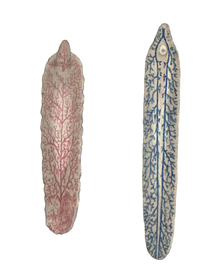Acetabulum (morphology)
Acetabulum
Etymology
Acetabulum literally means "a small saucer for vinegar". It is derived from two Latin words acetum, meaning "vinegar", and -bulum, a suffix denoting "saucer" or "vessel" or "bowl". The name is used because of the saucer-like structure in the invertebrates.[2]
Structure
Annelids

In leeches, acetabulum refers to the prominent posterior sucker at the extreme end of the body. In fact it forms a head-like structure, while the actual head is relatively small. It is a thick disc-shaped muscular system composed of circular, longitudinal and radial fibers.[4]
Trematode

In flatworms, acetabulum is the ventral sucker situated towards the anterior part of the body, but behind the anterior oral sucker. It is composed of numerous spines for penetrating and gripping the host tissue. The location and structure of the acetabulum, and the pattern of the spine alignment are important diagnostic tool among trematode species.[5][6]
Mollusc

Acetabulum in molluscs is a circular hollow opening on the arms. It occupies the central portion of the sucker and surrounded by a larger spherical cavity infundibulum. Both these structures are thick muscles, and the acetabulum is specifically composed of radial muscles. They are covered with chitinous cuticle to make a protective surface.[7][8]
Function
Acetabulum is essentially an organ of attachment. In annelids, it is used for adherence to the substratum during a looping locomotion. Annelid worms such as leeches move by repeated alternating extensions and shortenings of the body. This in turn is done by successive attachment and detachment of the oral sucker and the acetabulum.
Mollusc
Molluscans uses it for grasping substratum, catching prey and for locomotory accessory. The best studied acetabular activity is that of octopus. Octopus arms contains 200-300 independently controlled suckers that can grasp small objects and produce high adhesion forces on virtually any non-porous surface. This precise mechanism of high flexibility even has a potential mechanical applications in robotics.[11][12] Each sucker is a tactile sensor for detecting the surrounding. When the sucker attaches itself on an object, the infundibulum mainly provides adhesion while the central acetabulum is quite free. This provides greater suction on the flat surface; hence, making pressure incredibly low. This is why octopus grip is exceptionally firm. Then contraction of the radial muscle of the acetabulum causes detachment of the entire sucker.[7][13]
References
- PMID 21413252.
- ^ a b Collins Dictionary. "acetabulum". collinsdictionary.com. Collins. Retrieved 2013-06-08.
- PMID 17110356.
- S2CID 21324648.
- S2CID 253976749.
- S2CID 1981959.
- ^ PMID 21680399.
- ^ Walla G (2007). "A study of the Comparative Morphology of Cephalopod Armature". tonmo.com. Deep Intuition, LLC. Retrieved 2013-06-08.
- S2CID 9669237.
- S2CID 253978450.
- S2CID 41160108.
- S2CID 11569400.
- ^ Octopuses & Relatives. "Learn about octopuses & relatives: locomotion". asnailsodyssey.com. Archived from the original on 2013-05-22. Retrieved 2013-06-08.
